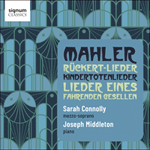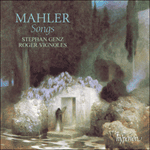
Welcome to Hyperion Records, an independent British classical label devoted to presenting high-quality recordings of music of all styles and from all periods from the twelfth century to the twenty-first.
Hyperion offers both CDs, and downloads in a number of formats. The site is also available in several languages.
Please use the dropdown buttons to set your preferred options, or use the checkbox to accept the defaults.

 PERFORMANCE
PERFORMANCE
In the first song, Wenn mein Schatz Hochzeit macht, the rustic setting is immediately audible in the asymmetrical piping of the wedding dance and in the calling of the birds, clearly differentiated from the sustained sonorities of the lover’s lament, which begins by withdrawing into itself, but then cannot help opening up again in widely arching phrases expressive of his grief. In Ging heut morgen übers Feld—which Mahler reused substantially in the First Symphony—he shakes off the gloom, under the influence of a bright summer morning. In the piano part all is burgeoning nature and bright fanfares of birdsong; only at the end does the contrast with his own lost happiness become too much for him.
Ich hab’ ein glühend Messer is the storm at the heart of the cycle, its emotional turmoil expressed in an exceptional vocal range from low D to high G and searing chromatics over stark open fifths in the bass. In the quiet central section ‘Wenn ich in dem Himmel seh’’, devotees of Schubert would not need Mahler’s own orchestration to recognize the two horns that represent the vision of two blue eyes. But the sepulchral E flat minor of the postlude, with its scurrying triplets, is pure Mahler. The final song, Die zwei blauen Augen von meinem Schatz, begins as a funeral march, but ends as a vision of emotional sublimation and release, the E minor of the opening yielding to an almost seraphic F major melody whose triadic contours are designed to release all the possible harmonic overtones of the accompanying pedal-point in the piano. By the end the funeral march has become a distant echo, suggesting a comparable emotional distancing of the singer from his grief.
from notes by Roger Vignoles © 2004
Dans le premier lied, Wenn mein Schatz Hochzeit macht, la mise en musique rustique se fait entendre d’emblée et dans le jeu asymétrique de la danse de mariage et dans l’appel des oiseaux, nettement différenciés des sonorités tenues de la lamentation de l’amant, qui commence par se replier mais ne peut s’empêcher de s’animer de nouveau dans des phrases traçant de larges arcs, expression de sa douleur. Avec Ging heut morgen übers Feld—repris pour une large part dans la Première Symphonie—, Mahler se défait des ténèbres, cédant à l’influence d’un clair matin d’été. La partie pianistique n’est que nature bourgeonnante, fanfares éclatantes de chants d’oiseaux, et c’est seulement à la fin que le contraste avec son propre bonheur perdu devient trop pesant pour Mahler.
Ich hab’ ein glühend Messer marque la tempête au cœur du cycle, son trouble émotionnel se traduisant par un exceptionnel ambitus vocal, de ré grave à sol aigu, et par de fulgurants chromatismes, sur d’austères quintes à vide, à la basse. Dans la paisible section centrale «Wenn ich in dem Himmel she’», les fervents schubertiens n’auront pas besoin de l’orchestration de Mahler pour reconnaître les deux cors qui symbolisent l’image des deux yeux bleus. Le sépulcral mi bémol mineur du postlude, avec ses triolets précipités, est, par contre, du pur Mahler. Le dernier lied, Die zwie blauen Augen von meinem Schatz, s’ouvre comme une marche funèbre mais s’achève en une vision de sublimation émotionnelle et de libération, le mi mineur initial cédant la place à une mélodie quasi séraphique en fa majeur, don’t les contours en triades sont conçus pour libérer tous les harmoniques possible de la pédale accompagnante, au piano. À la fin, la marche funèbre n’est plus qu’un lointain écho, marquant combien le chanteur s’est éloigné émotionnellement de sa douleur.
extrait des notes rédigées par Roger Vignoles © 2004
Français: Hypérion
Im ersten Lied, Wenn mein Schatz Hochzeit macht, ist der rustikale Schauplatz sofort im asymmetrischen Flöten des Hochzeitstanzes und den Rufen der Vögel hörbar, und er wird deutlich von den gehaltenen Klängen der Klage des Liebenden abgesetzt, einer Klage, die mit einem Rückzug auf sich selbst beginnt, dann aber nicht anders kann, als sich in weit ausholenden Phrasen, die seinem Schmerz Ausdruck verleihen, zu öffnen. In Ging heut morgen übers Feld, einem Lied, auf das Mahler in seiner Ersten Symphonie umfangreich zurückgriff, wirft der Erzähler angesichts eines hellen Sommermorgens seine düstere Stimmung ab. Der Klavierpart ist voll sprießender Natur und fröhlichem Vogelgesang; erst zum Schluß überwältigt ihn der Kontrast zu seinem eigenen verlorenen Glück.
Ich hab’ ein glühend Messer stellt den Sturm im Herzen dieses Zyklus’ dar, dessen emotionaler Aufruhr mit Hilfe eines außergewöhnlichen Stimmumfangs vom tiefen D bis zum hohen G und glühender Chromatik über harten offenen Quinten im Baß zum Ausdruck kommt. Im leisen Mittelteil „Wenn ich in dem Himmel seh’“ würden Schubert-Verehrer nicht der Orchestrierung Mahlers bedürfen, um die beiden Hörner, welche die Vision zweier blauer Augen symbolisieren, zu erkennen. Das düstere es-Moll des Nachspiels mit seinen huschenden Triolen ist jedoch wieder reiner Mahler. Das letzte Lied, Die zwei blauen Augen von meinem Schatz, beginnt als Trauermarsch, endet jedoch als Vision emotionaler Sublimierung und Erlösung, in der das e-Moll des Anfangs einer fast seraphischen Melodie in F-Dur weicht, deren dreiklangartige Konturen alle nur möglichen harmonischen Obertöne des begleitenden Orgelpunkts im Klavier freisetzen sollen. Zum Schluß ist der Trauermarsch nur noch ein entferntes Echo, was nahelegt, daß sich der Sänger in vergleichbarem Maße emotional von seinem Schmerz distanziert hat.
aus dem Begleittext von Roger Vignoles © 2004
Deutsch: Bettina Reinke-Welsh
 Mahler: Rückert-Lieder Mahler: Rückert-LiederOne of the finest Mahlerians of our time, Dame Sarah Connolly brings her fierce intellect and glorious voice to the music she has spent a lifetime studying and performing. This is the first release in a series curated and performed by Joseph Middl ...» More |
 Mahler: Songs Mahler: Songs‘This disc shows Stephan Genz entering his fourth decade with all the light suppleness and ardour of his youthful recordings, but now with darker colo ... ‘A rich sonorous eloquence from Genz, while Vignoles musters a full range of orchestral colours. Piano accompaniment lends these works a more personal ...» More |

